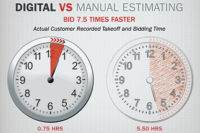New technologies are being introduced into the construction field at a dizzying rate, literally forcing construction professionals to adopt or risk being outpaced by competitors. A recent On Center technology survey of more than 900 construction professionals revealed many business and technology adoption issues that the industry is struggling with, and what moves are being taken to effect change. We’ll explore these issues and help to equip construction professionals with the tools to understand what technology options are available, the language of technology and how to select and move an existing analogue business to a digital platform for an effective, and appropriate, construction technology solution.
Long Standing Best Practices: Excel
Historically, the construction process has been governed by paper, in the form of architectural plans, takeoffs, estimates, spreadsheets and work orders. As our desktops moved to computer screens in the early 1990’s, a new software that seemed tailor-made for the estimating process entered the construction industry and has yet to yield its hold: Microsoft Excel. Excel is so ingrained in construction that whole generations of contractors have grown up with the concept that is it the best and only solution necessary. A well-known book, Construction Estimating Using Excel,(Peterson, 2011), cites its purpose as “give beginning estimators a basic understanding of how to use spreadsheets, such as Microsoft Excel, to increase their estimating productivity and reduce errors.” Most degree programs in construction and building technology also require coursework in Excel, indicating its pervasiveness in the field.
Excel does not integrate or feed every system that a company may adopt, including accounting or scheduling. Excel does not have the processing power for large, multi-user projects involving complex calculations. Excel requires users to build formulas into the spreadsheet that can be altered, creating false or erroneous results that can, theoretically, impact the profitability of a job.
Drivers for Change
Many solutions still in use by a workforce that is hanging onto old systems have created a situation where multiple iterations of data exist on a project. This is compounded by a lack of access that opens the door for potential errors through shortfalls in synchronization and collaboration. In a 2015 On Center construction technology survey, the ability to have “real time collaboration on projects” was cited as very important by most of the survey’s respondents. This was mirrored by the desire to have a “single source of data,” particularly in terms of evaluating software.
When construction professionals utilize tools that don’t integrate, data silos are created. A 2015 KPMG Global Construction Survey report (100 medium to large scale construction companies) found that 32 percent do not have full integration between their technology solutions. Fifty-three percent reported one or more underperforming projects in the previous year (KPMG International).
Companies begin to search for solutions when they have grown frustrated with the capabilities of current systems. This can be an intimidating and daunting task. What are the options? What are the differences between on premise and cloud solutions? What kind of hardware and software solutions does a company need? Making the transition to the next generation construction professional, able to cast a clear eye on these issues, requires an understanding of the players and the playing field. Here are the fundamental building blocks for these considerations.
Understanding the Hardware
The tools for change that may have been cost prohibitive in the past are now readily available. These include 3D laser scanners to capture accurate dimensions; 3D printers, Internet enabled printers, drones and even the new Google Glass, Enterprise Edition. While we will hear more about these jobsite accessories in the future, the biggest hardware drivers today are items that have matured and reached “hammer” status as construction tools: mobile devices. The computing power of phones and tablets has increased to the point where they are virtually as capable of performing most jobsite functions as a well as a light laptop. This opens up a wide variety of construction software and construction apps.
According to the On Center survey, more than 70 percent of construction professionals utilize some type of mobile device in the performance of their duties; construction analysts have seen increased usage of 35 percent year after year. These devices include smartphones and tablets. The advent of 4G and LTE networks represented a shift from focusing on delivering voice to delivering data.
For the construction professional, this infrastructure means that mobile devices can now become reliable sources of transmitting plans and photos, accessing cloud servers and conducting real time conversations and asset tracking.
Here is how these elements work together. Today’s hardware and powerful networks have ostensibly converted the jobsite into an extension of the office. We’ve discussed the backbone technologies: widespread adoption and use of mobile devices by construction professionals and a robust infrastructure capable of reliable and fast data flow. The enabling element in this scenario is the software or cloud based software platform connecting all sides of the communication channel through the mobile device. In a broader sense this reflects the maturation of the internet of things in the construction industry; which in and of itself can form the basis for an entire book.
Selecting Software
Understanding the language of technology is critical to making informed selections as a next generation construction professional. Licensed Software, SAAS and Cloud Solutions, all refer to different methods of delivery and software ownerships; and each has its own merits. Understanding these distinctions is a critical basis for any decisions. Specialized software exists for all phases of the construction process, including takeoff, estimating, production control, workforce management and accounting. These specialty packages are all available in varying formats. It is crucial to understand what these formats are to make an appropriate decision that solves the problems of a particular business.
SaaS and cloud computing are two terms that have grown, over the past five years, to mean almost the same thing; which has led to some market confusion. Originally SaaS, Software as a Service, referred to any software that was accessed online that did not reside on a company’s servers. Cloud computing used to be the realm of software developers and IT departments that needed virtual computers/servers, data storage capacity and development environments. However, software companies realized that there was a massive market for applications delivered to everyone, from one and two person businesses to full enterprises. Cloud computing became the “cloud” and levelled the playing field. Now any size business technically has access to enterprise class software.
Moving from Analogue to Digital
Making the change from an analogue (paper or Excel based) to a digital based construction company requires careful consideration of your needs. As previously indicated, most companies start with Excel. For purposes of this conversation, we’ll assume that a current company is using Excel or paper or a combination of the two. We’ll also assume that the company has reached a tipping point for one of many reasons, including, but not limited to, coping with errors, losing data, not having access to current data, managing redundant data, expanding or seeking to increase revenues through installing more efficient systems.
A construction professional with a working understanding of the technology options available can now confront change from an enlightened standpoint. A technology move should be approached with the same methodology as a construction project: it must be broken down into parts. The process begins with a needs assessment. This should include consideration of several fundamental issues:
- What issues is an organization struggling with? Is data loss a problem? Has a server crashed?
- Is it necessary to deal with inputs from multiple sub-contractors? Consider a solution that provides input into a single document from multiple sources. What are the mobile capabilities of these solutions?
- How many solutions does a company need? Specialized programs exist to cover every aspect of the construction building cycle. Is takeoff and estimating enough? Is collaboration during the project necessary? How long has the company producing the solution been in the marketplace?
- What type of integration is necessary? In an ideal world, your solution should integrate with other solutions in the marketplace. These can be solutions from the same company or other well-known and proven solutions.
Once a construction professional has determined the type of solution(s) that will fulfill a company’s needs, the selection process begins. It is critical to demo any solution under consideration. As a company begins a relationship with a new software vendor, it’s important to consider long term support:
- Does the company offer training?
- What does ongoing support look like?
- Does the company’s solution seem intuitive; familiar; does it seem to reflect construction industry experience and mindset?
- Does the company offer more than one solution, enabling future growth (i.e., licensed solutions and cloud solutions)?
- Was the company founded by construction professionals looking to provide business solutions for other construction professionals or by IT professionals seeking to impose their vision on the construction industry?
Conclusions
Once the construction professional has taken the steps to create a more technologically advanced company, interfacing with a rapidly evolving jobsite, expectations for increased efficiencies will occur naturally. This professional will be able to tackle the issues that have vexed the industry for decades. These include demanding a “single truth,” providing real time access to all participants in a project, having a readily accessible archive and minimizing errors.
References
Peterson, S. (2011). Construction Estimating Using Excel. Prentice Hall.
On Center Software. (n.d.). On Center Technology Survey. Retrieved from On Center Software: http://www.oncenter.com/products/oasis/landpage/infographic-survey-2015.html.
KPMG International. (n.d.). Global Construction Survey. Retrieved from https://www.kpmg.com/Global/en/IssuesAndInsights/ArticlesPublications/global-construction-survey/Documents/global-construction-survey-2015.pdf.






